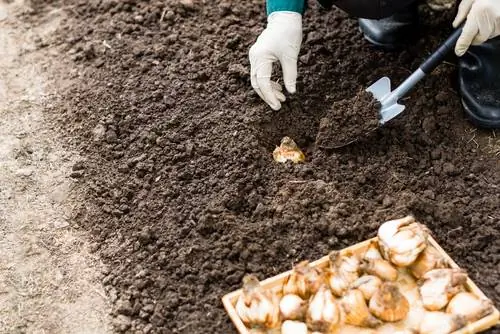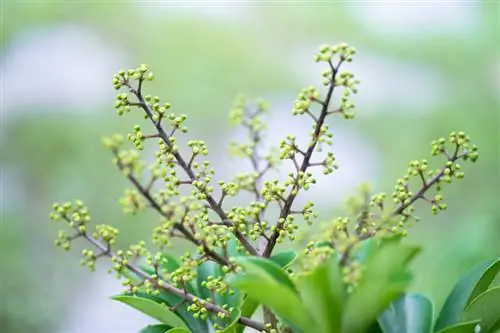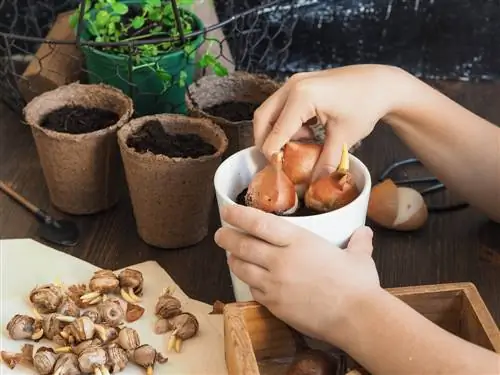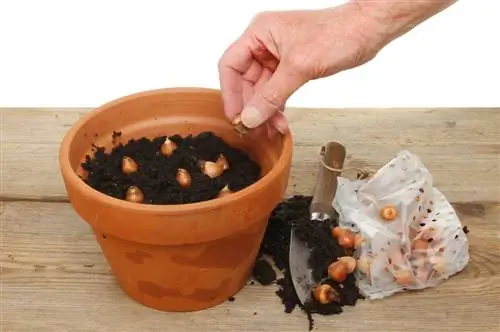- Author admin [email protected].
- Public 2023-12-16 16:46.
- Last modified 2025-01-23 11:19.
Many flowers that grow from a bulb, such as crocuses, tulips and daffodils, must be planted in autumn. The selection in the garden trade is huge: In addition to cultivated forms, you can also get wild forms and rarities in rare colors. But only if the bulbs are properly planted in the ground can you expect abundant flowering in spring.
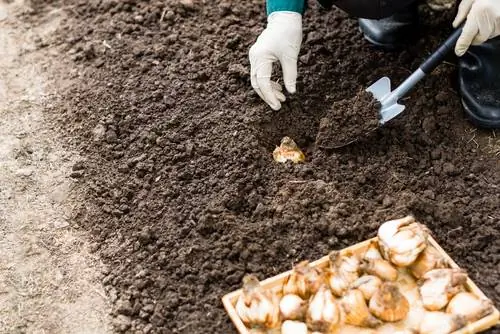
How do you plant flower bulbs correctly?
To plant flower bulbs successfully, choose fresh bulbs, the right location and follow these steps: Dig a planting hole twice as deep as the bulb, add a drainage layer and nutrient-rich substrate, plant bulbs with the tip up, with a humus-rich one Cover with soil and press down lightly. Pay attention to planting distance and watering.
Use fresh flower bulbs
Take a close look at the flower bulbs: the air-conditioned, dry air in many specialist markets and the frequent touching are not always good for the bulbs. If the nodules feel soft or are even starting to sprout, you should avoid buying them. The nodules will have already used up part of their nutrient supply and the flowers will be rather sparse.
Which location is the right one?
Almost all bulbous flowers prefer a place in the garden where they are surrounded by the rays of the spring sun. If the variety is also suitable for partially shaded locations, this is noted on the packaging. It usually also says whether the flower you have chosen is suitable for releasing into the wild or whether you have to take the bulb out of the ground in the fall.
Setting flower bulbs
Setting is actually quite easy:
- The planting hole must be twice as deep as the size of the flower bulb.
- You don't have to measure this, because many bulb flowers regulate the optimal depth themselves with pulling roots.
- To prevent the bulbs from rotting, you should put a drainage layer (€19.00 on Amazon) in the planting hole if the soil is compacted and clayey.
- Nutrient-rich substrate enables a good start.
- Always insert flower bulbs with the tip upwards and only gently press them into the ground.
- Cover the onions with humus-rich soil and press down lightly.
The planting distance for larger onions should be around eight centimeters; for small onions, three to five centimeters are sufficient. If the soil is dry, you should water the flower bulbs as moisture promotes root formation.
And what happens after flowering?
Do not cut off the leaves immediately, but let them dry slowly. This is the only way the onion can store the nutrients that are important for the next flowering season. However, everything that has faded can be cut off.
Whether you leave the bulbs in the ground or dig them up depends on whether you want to release the flowers into the wild or replant them annually. Both variants are possible.
Tip
Sometimes it is difficult to find the dead bulbs again. Just take a cell phone photo of the blossoms in spring. This makes finding the bulbs much easier and you can immediately see where you should find the nodules or where you should possibly put more bulbs in the ground.

